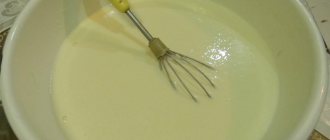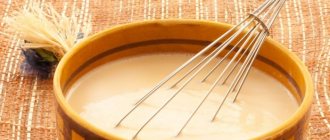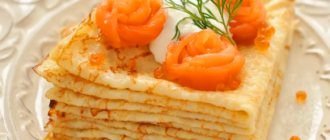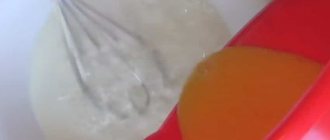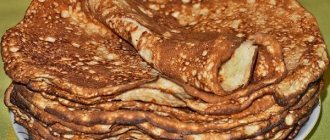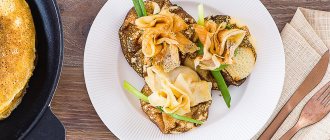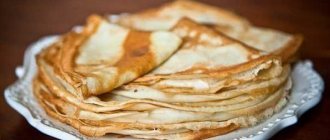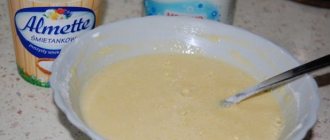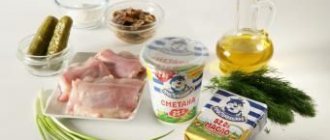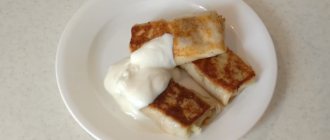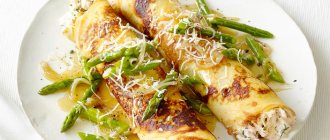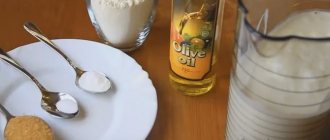Sometimes the pancakes turn out too dense, literally rubbery. Especially after they cool down. To prevent this from happening, it is recommended to listen to the advice of experienced chefs.
The quality of the finished pancakes depends on the frying temperature and the composition of the dough. The ratio of ingredients is crucial.
7 secrets why pancakes can turn out hard and rubbery:
- There is no or little baking powder (soda) in the dough.
- The density of pancakes is affected by the amount of flour. If there is a lot of flour component and few other ingredients, the pancakes will turn out dense and heavy. After cooling they become “rubbery”.
- A large number of eggs also makes the pancakes dense. The egg white is to blame for this. Eggs should be added only as a binding ingredient (1-2 pieces per liter of dough, no more).
- Batter that is too thick will result in thick, tough pancakes. If the pan is very hot, both sides of the pancake will quickly brown, but the inside of the product will remain half-baked.
- Pancakes will be rubbery in the center and brittle around the edges if little fat is used when cooking. It is recommended to add a sufficient amount of vegetable oil directly to the dough. Or apply it to the pan when baking each pancake.
- Butter will add softness to freshly baked pancakes. The finished pancakes are stacked on a plate. After adding every third or fourth pancake, a piece of hard butter is placed on it, which melts and is absorbed by those lying below.
- When preparing the dough, instead of milk, use yogurt, kefir, whey, sour cream, and fermented baked milk. Fermented milk products give pancakes volume and fluffiness.
Cooks recommend making pancakes using yogurt. This product contains aromatic additives and gives an unusual taste. Yogurt loosens the dough in the same way as yogurt and kefir.
TOP 5 recipes for pancakes [not rubber]
There are dozens of recipes for making pancakes. Experienced chefs can find both traditional and new recipes for making pancake dough.
Recipe with milk
This is a classic pancake recipe that produces tender and delicious pancakes.
✍ Ingredients:
- white wheat flour, premium - 300 g;
- milk - 0.75 l;
- 1-2 eggs;
- vegetable oil - a third of a glass (can be replaced with butter);
- granulated sugar - a tablespoon;
- soda - half a teaspoon (without top);
- salt to taste.
Preparation:
- Break eggs into a deep bowl, add soda, salt, sugar and beat the ingredients with a whisk.
- Add a glass of milk and beat the mixture again.
- Sift the required amount of flour and place it in a bowl.
- Knead the dough until smooth, trying to dissolve all lumps.
- Add the remaining milk and vegetable (or melted butter) oil and mix thoroughly.
- Leave the dough on the table (or in the refrigerator) for half an hour. During this time, the lumps will dissolve and the mass will become perfectly homogeneous.
- Mix the dough with a whisk again. Now it is ready for baking pancakes.
If you replace regular milk with baked milk, the pancakes will acquire a special, “rustic” taste. The aroma will be enhanced if the pan is greased with goose fat or a piece of unsalted lard.
On kefir [with video]
Fermented milk products allow you to bake beautiful openwork pancakes.
See also: Easter cake
✍ Ingredients:
- premium wheat flour - 2 cups;
- kefir - 0.4 l;
- 2 chicken eggs;
- a third of a glass of vegetable oil;
- water (boiling water) - 1 glass;
- half a teaspoon of baking soda;
- salt (to taste).
Preparation:
- In a large deep bowl, beat the eggs with a whisk.
- Pour kefir, add salt.
- Mix the ingredients thoroughly.
- Pour just boiled water into a glass and dissolve soda in it.
- Water is poured into the dough and kneaded quickly, trying to break up all the lumps.
- Cover the cup with a towel and leave for 5-7 minutes.
- Add vegetable oil and knead it. The dough is ready for frying pancakes.
How to turn pancakes so that they don’t tear in the pan - useful tips in the previous article.
Video recipe for pancakes with kefir
No eggs
Openwork and thin pancakes can be prepared without eggs.
✍ Ingredients:
- wheat flour (first or highest grade) - 300 g (20 tablespoons);
- glass of water;
- a glass of milk;
- vegetable oil - 6 tablespoons;
- salt to taste;
- a quarter teaspoon of baking soda;
- sugar - 2-4 tablespoons;
- a quarter teaspoon of table vinegar.
The dough contains a lot of water and will be liquid. Very thin pancakes are baked from it.
Preparation:
- Milk and water are poured into the pan.
- Add salt, sugar, vegetable oil and stir until dissolved.
- Measure out and pour in the pre-sifted flour.
- Knead the dough with a whisk or blender.
- Leave the pan for half an hour so that all the lumps dissolve.
- Place soda in a glass glass and pour vinegar. If necessary, mix the ingredients with a plastic spoon. Do not use metal objects, they react with acid!
- Add slaked soda to the dough, mix it thoroughly and start frying the pancakes.
The dough to which slaked soda is added should be baked immediately. If it sits for several hours, the quality of the pancakes will deteriorate and they will turn out flat and heavy.
By leaps and bounds [with video]
Yeast pancakes turn out porous and fluffy and never become “rubbery”. You can use both regular and instant yeast.
See also: How to make pancake mix: 4 popular dough recipes
✍ Ingredients:
- wheat flour (premium or 1st grade) - 2 cups;
- 6 grams of yeast Saf-moment (or others);
- a glass of milk;
- glass of water;
- 2 chicken eggs;
- 2 tablespoons of vegetable oil;
- half a glass of sugar;
- a pinch of salt.
Preparation:
- Break eggs into a large deep bowl, add salt and sugar.
- Beat the ingredients with a whisk until foam appears.
- Add warm water and slightly warmed milk.
- Yeast is measured on a kitchen scale and added to the bowl.
- Stir the ingredients with a whisk.
- Add flour and knead the dough until the lumps disappear.
- Place the pan in a warm place and keep in a warm place for an hour. During this time, bubbles appear in the dough, it rises and becomes thicker.
- Add vegetable oil and immediately bake pancakes. First, the frying pan is very hot, then the pancakes are fried over medium heat.
Video recipe for yeast pancakes from Irina Khlebnikova
Other secrets of making pancakes from professionals
To master the technique of masterfully baking pancakes, you need a stock of knowledge and practice. We offer you a list of useful pancake cook theory:
- Before frying, pour a thin layer of coarse salt into the frying pan and heat it. Afterwards, cool the pan and wipe clean with a dry cloth. Then the pancakes will definitely not stick to the surface, and it will be easier to turn them over. (This applies to cast iron pans)
- A cast iron frying pan with a thick bottom or a modern pancake pan with a non-stick coating, such as a ceramic one, is good for pancakes.
- If you add more sugar to the pancake mixture, the pancakes will be crispy, but will burn easily.
- The flour must be sifted. If this is not done, the dough may turn out uneven.
- Try adding yolks and whites separately. First, the yolks with sugar and salt, and then the whites, whipped until fluffy.
- If you add vegetable oil to the mixture at the very end, it will add elasticity. The pancakes will not tear or stick. Some recipes contain butter. You need to melt it before adding it to the dough.
- Experts advise leaving the finished dough for 10-20 minutes. Gluten, which is part of the flour, will be saturated with moisture and swell. The pancakes will turn out thin and airy. The dough will thicken a little as it sits.
- Perfectly whipped dough, without lumps, is the key to success. Leave this job to a mixer.
- Ready-made pancakes should be covered with a frying pan, then they will not dry out and the edges will not begin to break.
- If pancakes are fried in vegetable oil, they are best stored in the refrigerator.
The most delicious pancakes are those that are eaten right away!
? Interestingly, many cooks add soda. Is it really necessary? If you add soda to pancakes made with milk, they will turn out a little dry. It's actually great to cook without it. But in dough based on fermented milk products, soda is really needed, because... without it the dough will be hard.
See also: Why pancakes bubble in a frying pan: 5 reasons
Option by leaps and bounds
- A packet of dry yeast.
- 3 cups flour.
- A liter of whole cow's milk.
- 3 tablespoons sugar.
- 2 eggs.
- ½ teaspoon salt.
Before frying pancakes, you need to knead the dough. To do this, yeast is combined with flour and poured with heated milk. Vegetable oil and egg yolks, ground with granulated sugar, and whipped whites are also added there. Mix everything thoroughly, cover with a clean napkin and leave in a warm place for half an hour. After this time, the risen dough is placed in portions on a hot, oiled frying pan and fried for a minute on each side. Browned fluffy pancakes are served hot, after pouring them with sour cream, condensed milk or any jam.
Raw potato pancakes
Why do pancakes turn out rubbery? You may not have found the perfect recipe that's right for you yet. Experiment with the composition of pancakes and try different variations. To make potato pancakes, you will need:
- Peel one onion, 250 grams of potatoes and two cloves of garlic. Cut the prepared products into pieces and grind them with a blender.
- Add one egg to the resulting mass and beat again.
- Combine the potato mixture with one cup of flour, two tablespoons of olive oil, salt and pepper.
Fry the potato pancakes as usual, in a frying pan, frying them on both sides.
Why are pancakes tasteless?
no salt
Fresh food is always tasteless, and even pancake dough must be salted. The balance of salt and sugar creates a pleasant taste.
bad milk/kefir
There is a great temptation to save sour milk or expired kefir by making pancakes from them. If the products are so sour that they are already bitter or have unpleasant odors, you won’t get tasty pancakes. Milk from the store shelf often contains antibiotics, so when heated it begins to taste bitter.
Pancakes are not baked inside: proper frying
In addition, the reason that the pancakes are raw inside may be insufficient frying time. It would seem that an undercooked pancake would not even turn over, but no. It can be turned over and even served unbaked.
To avoid this trouble and to be sure to guess with time and heat, we do this: pour the dough into a hot, greased frying pan and keep it on it until bubbles appear, that is, regardless of its composition, the pancake should “fit into the hole.”
How much lace it will turn out to be depends, of course, on the recipe, but the air bubbles should come out.
In addition, the dough should be completely dry, without a hint of a “puddle” in the center. The baked pancakes will be easy to turn over and not stick to the pan.
Now you know what to do if the pancakes are not cooked inside and how to avoid this. Use simple recommendations, and your baked goods will never be soggy and gloopy inside. After all, you can bake with fresh milk, and with dry milk, and with fermented milk products with the same excellent result - the main thing is to know how to achieve it!
Subscription to the portal “Your Cook”
To receive new materials (posts, articles, free information products), enter your name and email

I’m surprised at our mothers and grandmothers: they throw the “hodgepodge” into a bowl, stir it with a spoon, stand in front of the refrigerator, think that there’s something lying around that could go into pancakes, fry the whole mess - and the result is a masterpiece! Modern housewives have a whole arsenal of tools: mixers, food processors, kitchen scales that weigh down to the gram, frying pans with a special coating, a wide variety of recipes - and... often lumps instead of pancakes. Let's figure out what the reasons for unsuccessful pancakes are, but first I'll share my video recipe, according to which pancakes always turn out well.
The key to success when baking pancakes: the correct proportion of liquid, eggs and flour. Once you work it out and understand what the consistency of the pancake batter should be, the pancakes will start to come out.
The main secret to the correct ratio of flour to liquid is 2:3, that is, for 3 cups of liquid you need to use 2 cups of flour. Use this rule, measure everything in glasses until you get the hang of it and can do everything “by eye.”
Pale pancakes: why they don’t turn brown
Some housewives cook pancakes using whites without adding yolks. Most often, pancakes mixed with such ingredients turn out pale.
How to deal with this?
- Significantly increased heat will help turn white pancakes into golden brown ones. On low heat, the batter will cook slowly and the pancakes will eventually become dry.
- Also, pancakes prepared without yolks brown well if you regularly grease the pan with oil.
- The main components of blush are sugar and milk. However, sugar without increased heat will also be powerless in the fight against the pallor of pancakes.
To cope with the main problems that arise during baking pancakes, you need to analyze the quality of the pan used, the ingredients and the proportional composition of the kneaded dough. Once a weak point that interferes with the preparation of a dish has been identified, it must be eliminated using the tips described above.
Pancakes are considered a classic of Russian national cuisine. They are prepared with milk, kefir, whey, boiling water or mineral water. Today's article presents an interesting selection of pancake recipes.
Despite the variety of existing recipes, they are all based on general principles, knowledge of which allows you to easily bake a stack of delicious pancakes. Water, milk, kefir or whey are most often used as the basis for preparing such a delicacy. In addition, the required components of the dough include eggs, wheat flour, salt, sugar and vegetable oil. If desired, add cinnamon, vanillin, cocoa or grated citrus zest. Thanks to these ingredients, the pancakes will not only be tasty, but also very aromatic.
It is advisable to use a cast iron frying pan for frying products. To prevent the dough from sticking to the bottom of the vessel, it is first sprinkled with salt, wiped with a clean napkin and greased with vegetable fat.
Hard and dry pancakes
There are several reasons why pancakes turn out tough and very dry. Let's look at them in more detail. The most common reason is improperly prepared dough.
Pancakes made from dough made with kefir or other fermented milk product will not be harsh. The main thing is to add soda. But if you overdo it (put more than a teaspoon per liter of dough), then you are guaranteed dry and brittle products.
Don't forget to also add sunflower oil in a ratio of two spoons per liter of dough. It also gives greater elasticity to the pancakes.
